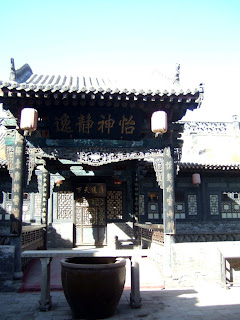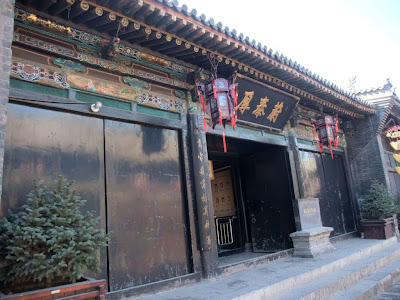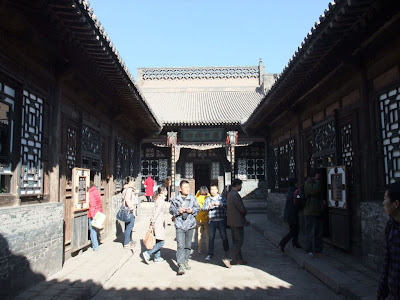
Pingyao Ancient City established during Spring Autumn War Period 2700 years ago turned into a financial center of China in Qing Dynasty. It is the birthplace of Jin businessmen and home to almost all the large exchange shops in China. There are as many as 22 financial institutions within the city at that time, which was almost half of the whole country. Most of the them were clustered in The South Street which later gained the street the name of China's Wall Street.



During Qing Dynasty, bulky and heavy silver coins are still the only currency used in the market. It was obviously not too convenient for traders to carry large sum of silver coin to travel from one place to another, and further they had to face security problem. Exchange shops offered a convenient alternative thus bills of exchange came into use creating an early form of banking.



After development of draft tickets in late Qing Dynasty, exchange shops provided services of money transaction for transfer, deposit and loan as well. The draft tickets were actually a draft known in olden days as Piaohao (票号) in Chinese. Traders traveled from one station in a province to the other, started carrying with them draft tickets instead of heavy taels.


Cash deposited at one branch of the exchange shop could be payable by means of a bill or ticket at another branch. It became a secure method of transferring funds from one businessman to another, regardless of time and distance.



The architectural structures that formed an integrated and comprehensive courtyards of commercial shops and store were mostly with distinctive characteristic.


The courtyards.


The courtyards.



An underground vault fixed with metal net with some bells on top to ensure a tight security and safety of the silver coins kept, was an essential structure in every exchange shop.


The founding of draft tickets (piaohao 票号) by exchange shops was a new development during late period of Qing Dynasty. After the establishment of the first draft ticket, bankers in Shanxi dominated China's financial market for centuries until the collapse of Qing era and the introduction of modern banks from western countries.



Exchange shop was a place where money first managed by bank.


The picture and wax figurines of the founder and the CEO of Changsheng-wei exchange shop (长盛蔚), which also had many branches in many parts of the nation.



The hall of Baoxia-Ding (包夏厅) in Chang-shengwei exchange shop was a structure built in Ming Dynasty. The building was classic and in the meantime also had its actual application purposes. It reflects the high standard requirement and taste of the businessman of that time.



There was a huge praying hall in Chang-sheng-wei exchange shop (长盛蔚)as the boss Wangchao-xiang (王朝相) was a sincere Buddhist. He enshrined in the hall a Buddha Image he took back from Wutaishan and made offerings every day to looking for a prosperous business and a happy life. He always educated his staff to understand that the business they did, mainly was for the country and people. When making an outstation trip, he or his staff would bow to the Buddha for a safe journey. The 18 Arahat images were some of his collections.



Pingyange (宾苑阁) at Changsheng-wei was a reception area built for a geisha named Shilixiang (十里香), who was bailed out from a prostitute parlour by the last chief cashier to entertain his customer. The area was finally abandoned as he received too many criticism from the same trades market. Shilixiang at last was released and returned to her normal life. The chief cashier unexpectedly concluded a meritorious deed.


Among the collections of Changsheng-wei, there was a nine dragons relief. The screen was made from yellow poplar wood with 110cm in height and 190cm in width. According to records, the relief was made by an unknown artisan during the reign of Emperor Qianglong in Qing Dynasty. The branch of Changsheng-wei in Tianjin obtained it from the market and kept as collection in the office. With unknown reason the relic floated into the market again but recovered later.


Weitai-hou (尉泰厚), the 2nd largest exchange shop at the ancient street was owned by Hou family (侯家族). The boss Hou-Wanzhan (侯万瞻) was the richest merchant in the region.


Tianji-xiang (天吉祥) was another exchange shop along the same street.


Among all the exchange shops, Risheng-chang (日升昌) which lies at the center of the old street, was the pioneer, the biggest scheme and most popular. At it's peak in 19th century, it controlled almost 50% economy of the nation. Besides the 35 branches widespread throughout China's urban cities and capital Beijing, Risheng-chang also set up offices in some western and south east countries. The exchange shop continued its prosperity for 108 years until the collapse of Qing Dynasty in year 1914 and when more and more modern banks began to setting up.

Risheng-chang (日升昌) which literally means prosperity in sunrise, was considered as the first bank in Chinese history. A renowned Chinese writer had stated it as the grandfather of all modern Chinese banks.



Risheng-chang had a great influence on the Chinese economy during the 108 years of its establishment. The exchange shop was converted from a dye shop owned by a business man named Li-Daquan (李大全) in year 1823 during Qing Dynasty with his partner Lei-Litai (雷履泰) as a general operation manager. In the following year, they set up a branch in Taiyuan which at that time was a hub of distribution and logistic center for Shanxi businessmen. Risheng-chang witnessed the prosperity of Jin merchants in the history of China and once controlled the life-line of Qing Empire in 19th century.




The shop compound of Risheng-chang has three courtyards and the 5 rooms facing the street in front of the compound served as the entrance area of the shop.


The original Risheng-chang exchange shop, fully restored in 1995, had turned into a museum providing a detailed history of banking in China.




There are three halls facing south in the second courtyard. One of the them was the conference room for reception important customers and meeting with sales personal to understand the flow and rate fluctuation in market. The shop hired 4-5 people to in- charge of customers' deposits, loans, withdrawals and in the time responsible to collect market information relating to the business.



Second floor of the central hall are rooms for working staff and storage purposes.


The 3rd courtyard served as a resting place for VIP customers and also an living quarter for the senior officials.



The table that used to issue bill of exchange or draft tickets.



The place where the chief accountant and his assistant with 2-3 staff worked, was an important office, as it was a control panel for the cash flow of the main bank and its branches. The profit and loss account statement was worked out by these group of people at this room by the end of every year.



The accountants had their own resting place inside the compound.


The 4 cashiers' offices were situated in the first courtyards on either side of the passage that ran along the axis of the compound.




Lei-Litai (雷履泰), was the chief officer of Risheng-chang Exchange Shop for 25 years since he partnered with Merchant Li-Daquan (李大全)and converted Li's dye shop Xiyu-cheng (西裕成) into an exchange shop. They opened the first page of banking industry in China with a starting capital of 30,000 taels in year 1823 during a turbulent time in Qing Dynasty. Though there were a lot of foreign aggression and internal disorder at that period, Risheng-chang survived and flourished for 108 years. Lei-Litai, with his enthusiasm, aggressiveness and past experiences, led his team of subordinates working out strategy and management system, setting up rules and regulations, opening branches and hiring efficient personals, making Risheng-chang the most reputable trustworthy bank in the nation. Their transaction could reach to an amount of as much as 1-38 million of taels.



A display of large abacus used, office table, cabinet that kept accounting ledger books, a seal and one of the underground "cash" storage room.



The hall at the back yard was once a place where the senior staff of Risheng-chang had their dinner and entertained their important guests, especially during festivals. The place now displayed some important relics of the exchange shop that had enormous influences upon development of banking in China. The plague inscribed with 4 Chinese characters (汇通天下) which means money channeled through Risheng-chang was able to reach any parts of the country, clearly reflects the success of this first bank of China.



Production and issuing of the draft tickets from the exchange shop were very very strict and no mistake was allowed. In order to work efficiently, Risheng-chang introduced the world's most advanced printing technology by then, using water-marks to produce and print their draft tickets. On top of it, each of their draft ticket was stamped with a seal at the key point. The amount and recipients of the draft tickets were strictly under control.



The draft tickets from Risheng-chang were written by professional officials in the main office. Handwriting on the drafts must use ink brushes and must be simultaneously bulletined before sending to the other 35 branches. The drafts were actually executed with codes in Chinese writings (instead of the numbers)and password was regularly changed to avoid disclosing of confidential information. Obviously, these kind of coding could not be decrypted by other people or hackers, as so far in the history of Risheng-chang, money falsely claimed never happened. The wisdom and intelligence of Risheng-chang's operating team were fully embodied.


Some of the seals.


The transaction records.


The annual dividend statements.



Hanging at a wall of Risheng-chang was a map of Pingyao ancient city, Risheng-chang's management operation chart, and a scale of its interest rate.



Lei-Litai was the key man behind the success of Risheng-chang which had now turned into a musem providing an insight for the visitors to understand the banking history of China and in the meantime understand how Shanxi merchants made a vital contribution to the development of Chinese Trade.



Network of the exchange shop.


The horse-drawn cart used by Risheng-chang's managers when they traveled. A horse-drawn cart was the symbol of wealth and rank in the past.



Risheng-chang's kitchen and some of the cooking utensils at that period.




The home of Lei-Litai, the founder and general manager of Risheng-chang Exchange Shop, the first and biggest bank which deals in money exchange in early China.



Lei-Litai (1770-1849) though was a renown great business man in the trade market, he was real cautious, frugal and in moral (慎俭德)in his daily life, as stated in the tablet hanged at his door. At age of 13, he left school to become a business apprentice and bought over the company's share 3 years later. He worked for Merchant Li-Daquan in his Xiyu-Cheng Dye shop for 15 years (1808-1823)and was in the position as a chief manager in Li's head plant in the last 5 years. In year 1823 at age of 53, he made Li's dye shop converted into an exchange shop and named it as Risheng-Chang. It was the first money exchange shop in the nation. He contributed his 25 years of life in Risheng-chang making it flourished for 108 years. Lei-Litai was an outstanding man of ingenuity.



Some corners of Lei-Litai's residence at the ancient city.




We would like to acknowledge the exceptional service that we received during the entire refinancing process. Mr Lee's professionalism and knowledge of the loan company was impressive and truly appreciated. Mr Lee is a reliable loan officer.In the past, we have had experience with several other banks and have found the process frustrating and tedious. Mr Lee went above and beyond to ensure that all of our needs were met and that everything was handled thoroughly and efficiently. We have and will continue to recommend him in the future.”Mr Lee Contact Email 247officedept@gmail.com Whatsapp +1-989-394-3740
ReplyDelete